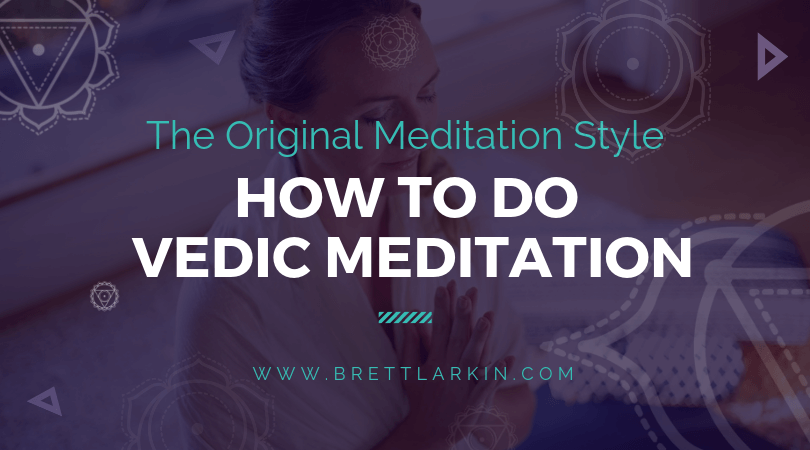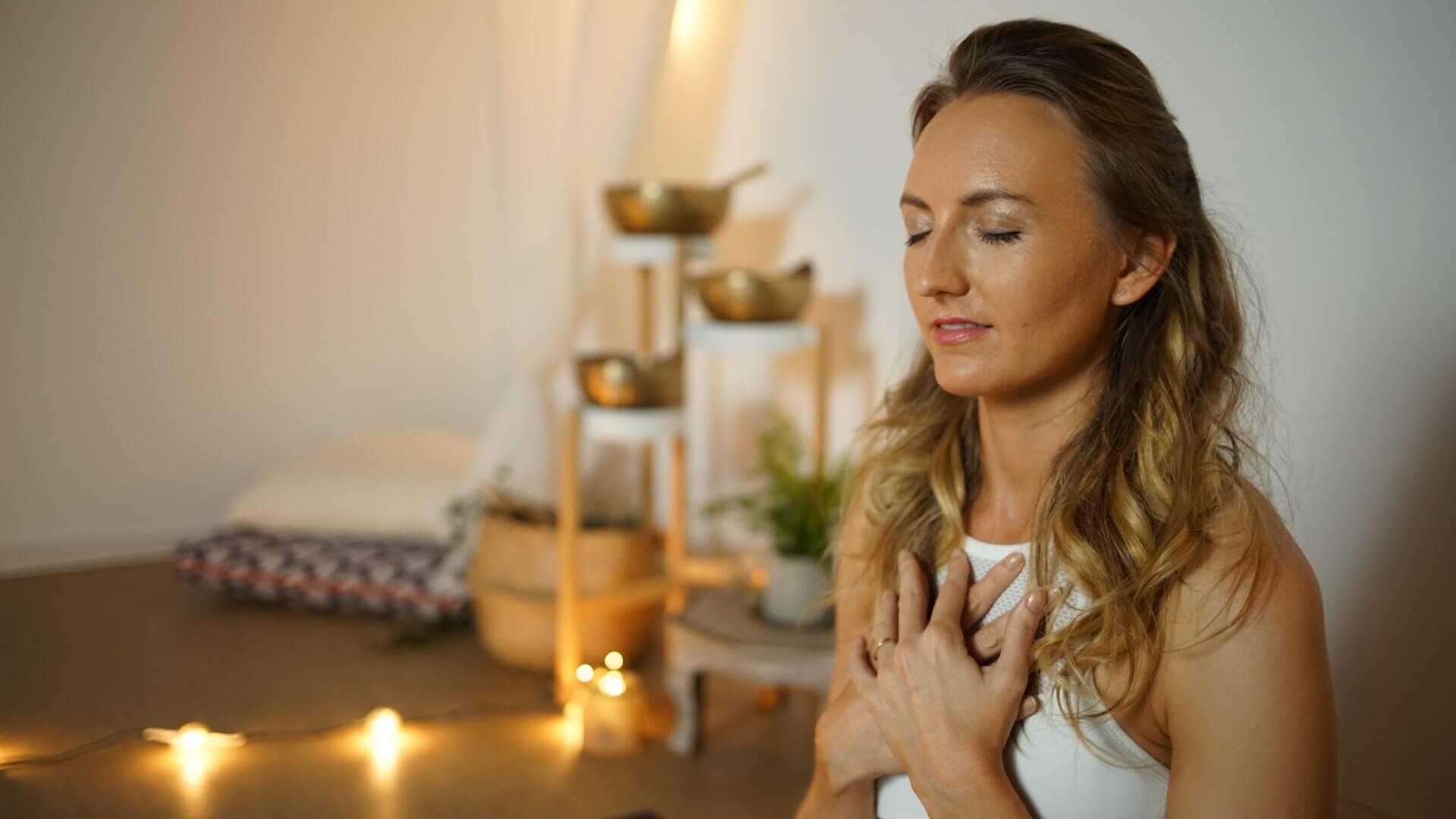
You may have heard of meditation before.
I mean, all of the stars and Twitter junkies are talking about it. Even Katy Perry talks about her daily meditation practice.
So what is it?
Well, it *actually* comes from Vedic meditation, the oldest documented form of meditation by the Vedas from which all other forms of meditation were born. But then some modern westerners put a new name on it with a new package and made it a popular trend.
(A very good one, if you ask me)
But what makes Vedic meditation special? What separates it from other mindfulness practices?
Well, Vedic meditation is the original form. It is where all other Indian-based meditation styles come from (even the fancy name-brand styles you see online today).
After all, meditation is simply a peaceful practice that gives us so many health benefits and stress relief.
The truth is, meditation is a calming practice that comes in many different flavors and all of them help us improve our happiness and well-being. Experienced yogis and newcomers alike always have more to discover when it comes to meditation practice.
Like the truth about where their meditation practice comes from.
Like getting back to the roots to Vedic meditation, the original meditation style as taught by the Vedas and described in the 8 Limbs of Yoga.

What is Vedic Meditation?
The most recent meditation movement was in the 70s, when the Beatles began to practice it (as did the Beach Boys) in Rishikesh at this hidden ashram at the top of the hill.
From there, we saw its popularity skyrocket. Celebrities like Clint Eastwood and Arnold Schwarzenegger still endorse it today. It’s estimated that between 200 and 500 million people practice meditation all over the world.
Vedic meditation is an ancient mantra meditation, which is derived from ancient Hindu Sanskrit phrases that have been around for thousands of years. This form of meditation is a valuable therapeutic resource based on Ayurvedic medicine and Hindu principles that is used in daily sadhana practice by yogis around the world.
As with all age-old teachings, the tradition of Vedic meditation would come and go in the throes of time. With that comes distortion of knowledge and misunderstanding throughout history.
As a result, some of the original lessons of Vedic meditation became lost with time.
Or worse, have been turned into a commodity, complete with brand trademarks and lawyers who threaten to sue.
But that’s not what meditation is about.
In fact, it’s a little bit like how the US courts rejected Bikram’s request to copyright his yoga sequence, claiming that you can’t patent something as ancient and universal as yoga.
The same goes for meditation.
Because all meditation, even the Buddhist kind, comes from Vedic meditation.
A Brief History Of Vedic Meditation
Vedic meditation begins with the Vedas, ancient religious texts from India that serve as the foundation of Hinduism and yoga.
Yoga as a complete practice is based on the Yoga Sutras, which was later simplified into an easy-to-digest framework known as the 8 Limbs of Yoga.
And one of those limbs is dhyana, or meditation.
Unlike what many westerners believe, yoga is a lifestyle that includes much more than just the physical practice (and is why I’m so obsessed with it).
A great meditation teacher by the name of Swami Brahmananda Saraswati restored this ancient art of meditation in the early 20th Century. He passed this renewed knowledge to his dedicated pupil, which for legal reasons we cannot mention his name on this website.
(You can read more about the legal feuds and ironically unpeaceful bullying approach that his disciples and their lawyers are taking today here.)
This pupil brought the practice to the west and designed a unique training program for its students with the end goal of spreading world peace, one meditator at a time.
The key difference between Vedic meditation and basically every other type that follows is that many of the newer versions are marketed as an exclusive trademarked practice…
…though truthfully any kind of meditation practice is for everyone.
Up to 500 million people, to be exact.
And Vedic meditation is absolutely free and welcoming to anyone and everyone.
Now, it’s easier than ever to reap the benefits of meditation with this simple practice, no matter how busy or hectic you feel your life may be.

4 Major Benefits of Vedic Meditation
Besides the fact that it is ancient yogic philosophy that tells us that Vedic meditation does good things for you, science tells us the same.
It’s been studied to death because westerners like to know that something is supported by science before they give it a try.
And guess what?
Science says it’s good! Thanks, ancient yogis.
1. Reduce stress and anxiety
Achieving deep relaxation helps you cope with the stresses of everyday life and a regular meditation practice can for sure help you relax.
By practicing (any kind of) meditation regularly, you can help your body respond to stressful situations in a healthier, calmer way. People who suffer from conditions like anxiety, depression, or post-traumatic stress disorder can also heal with the help of a meditation practice. Several studies have reported that meditation helps decrease anxiety traits and reduce depression. This practice is even embraced as a potential tool for college students to prevent stress related to their studies.
2. Boost cognition and unleash creativity
Achieving blissful peace can do more than just bring about relaxation, it can also unlock your imagination. In fact, it’s safe to say that mindfulness and meditation can help you develop your creativity in ways you’ve never seen before.
By clearing the clutter of daily thoughts and anxieties that pool in your mind constantly, you suddenly see new perspectives of your reality.
A Taiwanese study found that high school students who participated in a trademarked meditation style improved scores in tests evaluating creativity and cognitive ability. Their scores were much better compared to students who didn’t meditate or those who napped instead of meditating.
Another Chinese study found the benefits of short-term meditation on mood regulation and creative thinking in college students.
Basically, meditation makes your brain work better.
3. Improve sleep quality
If you’re tossing and turning at night, Vedic meditation may be a helpful solution. Today, many people struggle to get a restful night’s sleep. Some resort to medications that have serious side effects and may be bad for our health in the long run.
The worst part?
Sleepless nights are a vicious cycle, a self-fulfilling prophecy that drives stress and anxiety as the more you lie awake at night the more anxious you get about lying awake at night.
People who suffer from chronic insomnia find it difficult to get out of this cycle. That’s where mindfulness practices can come in to help break that cycle and help us sleep better. A 2015 scientific review reported two studies that observed immediate, positive effects on sleep after meditating.
4. Improved cardiovascular health
Stress can wreak havoc on our bodies. That’s why meditation can be so helpful in managing stress and improving our overall health.
Don’t get me wrong, there are many kinds of meditation and relaxation techniques. Homegirl loves a good self-care evening in.
But Vedic-based meditation techniques have the most science behind its effectiveness. In fact, a meditation practice is associated with reducing blood pressure and reducing heart disease as well as its risk factors. Though we don’t know the exact mechanism, it’s been thought that meditation improves our bodies’ physiological responses to stress.
This 15-minute meditation and mindfulness practice will take you on a journey through your three lowest chakras to plug your awareness into the supportive energy of the Earth.
Whether you are connected to your chakra system of subtle internal energy or not, you can reap the rewards of this stress reduction exercise.
Notice how you feel as your body rests on the Earth and use guided breathing to visualize sending your breath all the way from the crown of your head deep into the fiery core of the planet.
Allow the fire to incinerate anything that does not serve you, including the symptoms of depression or anxiety disorder.
7 Meditation Techniques According To Vedic Texts
If you’ve ever tried meditation, you might be thinking about how hard it can be to clear your busy mind completely. Well, the good news for you is that with Vedic meditation, you’re not encouraged to clear your mind at all. Instead, it’s more about acknowledging those busy thoughts and then practicing to let them go.
The best part is that you can pretty much practice Vedic meditation anywhere, especially in the comfort of your own home!
This practice is unique because it’s focused on mantra meditation. Most meditation practices use image guidance or phrases to help you get into the zone. Vedic meditation often uses a meaningless sound instead, though some practitioners will use Sanskrit chants too.
Here are seven steps to start practicing Vedic meditation today.
1. Choose a mantra
The mantra in Vedic meditation focuses on both vibration and sound. Choose something that can give you a resonant sensation through your body but also has lack of meaning, so you can let your mind float blissfully into a quiet calmness. Using anything like a phrase or word could counteract the goal of peacefulness and bring you back to the worries of the present, not allowing you to “transcend” below into pure consciousness. The vibration of the sound and its resonance will attract the mind, taking it away from the worries and thoughts that linger throughout the day. This resonance will also help our minds move towards happiness and peace. Bija mantras a perfect for this meditation practice.
2. Find a peaceful setting
It’s more difficult to get into that deep relaxation if your body isn’t in a restful position, so get comfortable. Sit up without crossing your legs, and maintain good posture in your back. Try sitting on a pillow for adjustment and perhaps something to support your back in good posture. Make sure your head and neck remain free and relaxed. Next, pick a spot that is most peaceful to you. You might enjoy being outside in your yard, or maybe your bedroom is where you find your zen.
However, if you’re busy and in a pinch, you can pretty much practice this exercise even on the train, or on a bus – wherever you can snag a seat and sit upright! Explore a little! Everyone’s zen is a little different, and whatever works for you is going to be totally okay.

3. Observe your physical being
Once you’ve settled into your comfortable seated position, turn your attention next to your body. Notice your breathing and let your mind follow the movement of your chest as it rises and falls rhythmically. Sense the way your body rests on the base supporting you. Acknowledge your posture and how your back feels against the support, if you are using one. Take a few deep breaths and allow your physical body to relax. Open and close your eyes a couple times, then close your eyes for the rest of your meditation.
4. Focus on your mantra and acknowledge your thoughts
In your relaxed state, focus on the mantra you have chosen for yourself. Allow it to be the major presence in your mind and notice as your thoughts float in or linger in your mind. Acknowledge these thoughts and then let them go. Imagine them floating away into oblivion.
Focus on the mantra and let that go too.
It may take a bit of practice, but that’s okay. Some people find it easier to use mantra chanting out loud. See what works for you and acknowledge the process of learning. It’s all about repetition and you’ll find yourself getting better at this with time.
5. Ease back into your physical being
After about 20 minutes of meditation, you can ease yourself back into your physical body. Begin by moving your fingers and toes. Wiggle them gently, and slowly bring your attention back to your body. Pay attention to how it’s supported beneath you, notice the position in which you’re seated, and follow your chest as it rises and falls with your breathing. Lastly, slowly open your eyes.
6. Express gratitude and reflect
At the end of your practice, take a few moments to maintain that deep relaxation before moving on with your day. Sit still and thank yourself for the time you took for you and your overall health. Focus on the meaning of this exercise and remind yourself of your intentions. Learn from your body and feel how differently it seems compared to the start of your session.
7. Practice, and more practice
It may take weeks, months…even years before you really feel comfortable in your daily practice. It’s a learning process, but you might find that you look forward to your sessions more and more each day.
And I bet you will because you can begin to feel the effects within the same day that you begin your practice.
Whether you choose to join a meditation center, or prefer to practice alone, meditation can help you find your inner peace and happiness. With regular practice, Vedic meditation improves your overall health and well being. Remember, the more you dedicate to the practice, the more you find yourself receiving. You may find yourself getting more comfortable with the process as you gain more experience. Trust in the rewards and meditate daily!
Ready to get started?
Learning Vedic meditation can be totally up to you. There are many meditation teachers out there that will run a meditation program, or you can choose to practice on your own too.
Whether you seek out a meditation teacher or not, the most important thing is to not be hard on yourself. It looks easy, but meditating is harder than it looks, especially in the middle of a busy day or amidst a stressful time.
But practice makes perfect! You’ll quickly find that the more you simply try, the sessions get easier every day.
There are many meditation centers that provide courses on meditation. It’s totally up to you whether you’d like a guide to teach meditation.
But the truth is that many organizations have formed to commodify this ancient practice that is absolutely, totally free and available to you right from home.
So if you’d rather learn on your own, you can 100% do that too! I’ve just given you a step-by-step approach to different meditation techniques that you can try at home.
It’s simple and it’s convenient. It’s ready when you are.
Next Steps
- Check out my YouTube channel and find some yoga classes that you can try out for yourself!
- Download my Yoga Calendars for an at-home practice, guided by me on YouTube!
- Join Uplifted for exclusive content that you can access right from the app. Take a deep dive into your practice with me this year!
Experience 3 Training Videos from Inside My 200-Hour Online YTT

YOU MIGHT ALSO LIKE
- What is Kriya Yoga? The Philosophy and Practice
- Uddiyana Bandha: Tapping Into Your Deep Core
- 4 Reasons Hasta Bandha Is Essential To Your Yoga Practice
- Vitarka Mudra: What It Is and How Do You Use It?
- Shakti Mudra: What It Is and How Do You Do It?
- Garuda Mudra: What It Is and How Do You Use It?
- Kali Mudra: What It Is and How Do You Do It?
- Shunya Mudra: What It Is and How Do You Do It?
- Varuna Mudra: What It Is and How Do You Use It?
- Vayu Mudra: What It Is and How Do You Use It?
- Samana Vayu: The Energy of Balance & How to Access It
- Apana Vayu: The Energy of Release & Surrender
- Udana Vayu: The Ascending Wind
- Prana Vayu: The Breath of Vitality
- Vyana Vayu: The Energetic Secret to Flow









